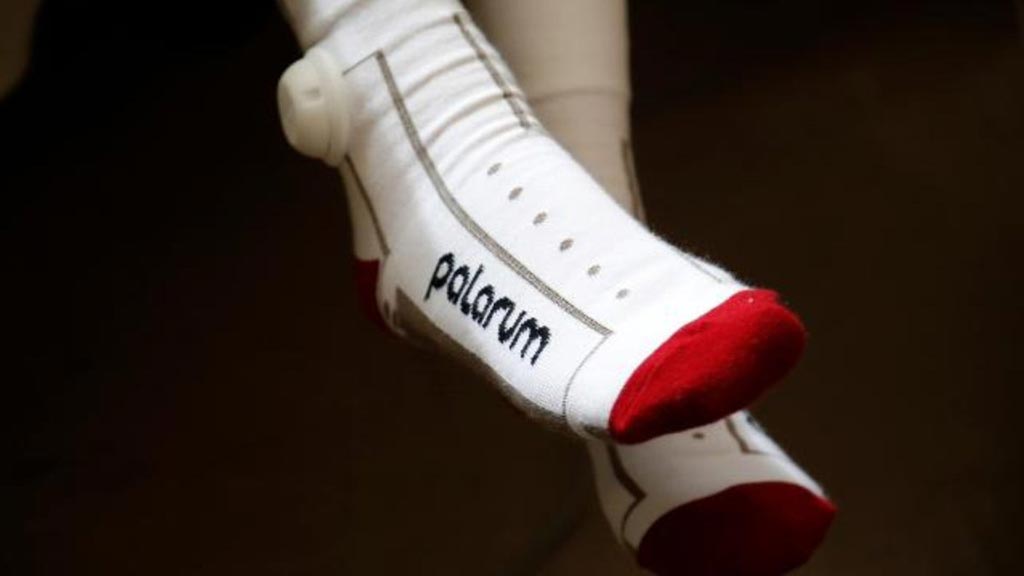

If you have ever seen or responded to a patient falling, you’re not alone. Patient falls are the most common adverse events reported in hospitals. Around 700,000 to 1 million patient falls occur in U.S. hospitals every year, resulting in around 250,000 injuries and up to 11,000 deaths. About 2% of hospitalized patients fall at least once during their stay.
But smart socks could help bring those numbers down.
A group of nurses at Ohio State University Wexner Medical Center (OSUWMC) recently wrapped up a clinical trial that analyzed whether Palarum’s PUP (Patient is UP) “smart” socks could be used to reduce the number of patient falls.
The socks come with a series of smart wireless sensors that can detect when a patient is getting ready to stand up or trying to walk without assistance. The system then sends an automatic alert to the three closest nurses in the facility via smart badges they keep on their person, so they can intervene if necessary.
The study involved 569 “high fall-risk” in-patients at the hospital’s neurological and neurosurgical units, according to Palarum, which is based in Lebanon, OH. Every patient in the study was fitted with the company’s smart socks, which tracked their movements throughout the hospital. Over the course of 13 months, the nurses used the system to respond to potential fall incidents. They reported zero patient falls by the end.
According to the results published in the Journal of Nursing Care Quality, there were 5,010 safety alarms from the system. Only 11 turned out to be false alarms, which means around 98% of the time the patient was trying to stand up when the alarm was sent, researchers said. The median nurse response time was 24 seconds.
“We observed zero falls, which was a lower fall rate among the patients wearing these socks than the historical fall rate of 4 falls per 1,000 patient-days,” said Tammy Moore, PhD, RN, senior study author and associate chief nurse of Ohio State’s Neurological Institute.
The success of the study marks the culmination of years of hard work on the part of Palarum.
“We hope to demonstrate that the fall rate among this patient population will decrease with the use of Palarum’s PUP sock,” stated Patrick Baker, president and CEO of Palarum.
And the results lived up to his expectations.
“We expect the results of this study to mirror those of previous studies conducted that showed a significant reduction in patient falls when the PUP sock is used. We are also actively engaged with healthcare organizations around the country to evaluate the PUP system with their patients,” Baker said in anticipation of the announcement.
The nurses at OSUWMC also praised the technology’s ability to prevent falls.
“Falls can have widespread and significant impact on health; they can be serious and often result in high costs and additional days in the hospital,” Moore added. “The best way to reduce falls is to prevent them.”
The sensors on the socks last about five to seven days before they need to be charged. Once the patient has been discharged from the hospital, the sensors are removed, cleaned and charged. The socks are laundered with the rest of the hospital’s linens.
Patrick Baker said the socks could be reused up to 50 times, although cleanliness will likely limit the number of uses to about six.
According to Palarum, the PUP smart socks can:
Baker said he was inspired to create the socks after spending over 30 years in the healthcare industry, mainly as the vice president of patient care services and chief nursing officer with the University of Cincinnati Health System. “Everybody already gets a sock when you go to a hospital,” he said. “Why not have it be a smart sock that can help keep our patients safer?”
He thinks they can be particularly useful for elderly patients, who could face serious injury if they lose their balance. Baker noted that the average age for hospital patients is 65 and the average cost of these falls comes in at just over $10,000 per incident.
“I see firsthand the impact on patient safety that people have with patient falls,” he said. “You add up a million patient falls at $10,200, you’re talking a lot of money.”
Baker said the company is starting to look into artificial learning and intelligence to help the socks better detect potential fall emergencies and reduce the number of alerts nurses receive on the job.
“At the end of the day,” he said, “this is all about patient safety.”
In a shocking incident on December 4, 2024, Brian Thompson, the CEO of UnitedHealthcare, was…
In an unprecedented step toward financial relief and health equity, the city of St. Paul,…
In early November 2024, a shocking tragedy unfolded in Budapest, Hungary, as American nurse Mackenzie…
If Robert F. Kennedy Jr. were to assume leadership of the U.S. Food and Drug…
On November 1, 2024, federal authorities charged 38-year-old Rebecca Fadanelli, owner of Skin Beaute Med…
In a quaint little restaurant in Echo Park, an up and coming author is sitting…